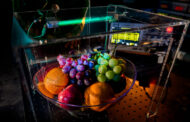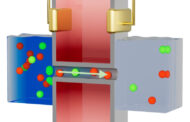That they have the potential to produce cheaper electricity than coal-fired generators can
SUNLIGHT is free, but that is no reason to waste it. Yet even the best silicon solar cells—by far the most common sort—convert only a quarter of the light that falls on them. Silicon has the merit of being cheap: manufacturing improvements have brought its price to a point where it is snapping at the heels of fossil fuels. But many scientists would like to replace it with something fundamentally better.
John Rogers, of the University of Illinois, Urbana-Champaign, is one. The cells he has devised (and which are being made, packaged into panels and deployed in pilot projects by Semprius, a firm based in North Carolina) are indeed better. By themselves, he told this year’s meeting of the American Association for the Advancement of Science, they convert 42.5% of sunlight. Even when surrounded by the paraphernalia of a panel they manage 35%. Suitably tweaked, Dr Rogers reckons, their efficiency could rise to 50%. Their secret is that they are actually not one cell, but four, stacked one on top of another.
Solar cells are made of semiconductors, and every type of semiconductor has a property called a band gap that is different from that of other semiconductors. The band gap defines the longest wavelength of light a semiconductor can absorb (it is transparent to longer wavelengths). It also fixes the maximum amount of energy that can be captured from photons of shorter wavelength. The result is that long-wavelength photons are lost and short-wave ones incompletely utilised.
Dr Rogers gets round this by using a different material for each layer of the stack. He chooses his materials so that the bottom of the band gap of the top layer matches the top of the band gap of the one underneath, and so on down the stack. Each layer thus chops off part of the spectrum, converts it efficiently into electrical energy and passes the rest on.
The Latest on: Efficiency of solar cells
[google_news title=”” keyword=”Efficiency of solar cells” num_posts=”10″ blurb_length=”0″ show_thumb=”left”]
via Google News
The Latest on: Efficiency of solar cells
- How Many Solar Panels Does It Take To Power An RV/Motorhome?on April 26, 2024 at 11:15 pm
Solar power for RVs is taking off, so if you're looking to add some solar panels to your vehicle, it can take some math to figure out exactly what you need.
- JinkoSolar: Strong Operational Efficiency Makes It A Buyon April 26, 2024 at 10:41 pm
Jinko Solar leads in solar module manufacturing, contributing to China's economic growth and global influence through clean energy. See why JKS stock is buy rated.
- Energy Efficiency is Critical for a Sustainable Futureon April 26, 2024 at 9:00 am
Governments must prioritize energy efficiency and reduce energy waste to achieve clean energy security and combat climate change.
- Researchers outline path forward for tandem solar cellson April 26, 2024 at 7:23 am
As the old saying goes, two heads are better than one. The same is true when it comes to solar cells working in tandem. Researchers at the U.S. Department of Energy's National Renewable Energy ...
- Scientists develop material with potential to revolutionize solar panel efficency: 'Significant leap forward'on April 26, 2024 at 3:15 am
Researchers at Lehigh University have developed a solar panel that is nearly twice as efficient as most existing solar panels, using something called "quantum material." External quantum efficiency ...
- Engineers uncover key to efficient and stable organic solar cellson April 25, 2024 at 7:56 am
A team of researchers led by Professor Philip C.Y. Chow from the Department of Mechanical Engineering at the University of Hong Kong (HKU) has made a significant breakthrough in the field of organic ...
- The Myths And Truths About Why Electric Cars Don't Have Solar Panelson April 25, 2024 at 7:00 am
Although solar energy alone cannot fully power a car for real-world usage, manufacturers are overcoming challenges and getting closer by the hour.
- Key to efficient and stable organic solar cellson April 24, 2024 at 5:00 pm
Their research, titled "The role of interfacial donor-acceptor percolation in efficient and stable all-polymer solar cells," paves the way for more sustainable and viable solar energy solutions for ...
- A shade closer to more efficient organic photovoltaicson April 24, 2024 at 10:00 am
Transparent solar cells will transform the look of infrastructure by enabling many more surfaces to become solar panels. Now, materials called non-fullerene acceptors that can intrinsically generate ...
- NREL updates interactive chart of solar cell efficiencyon April 24, 2024 at 8:44 am
The US National Renewable Energy Laboratory (NREL) has updated its research cell efficiency chart for a range of PV technologies.
via Bing News








